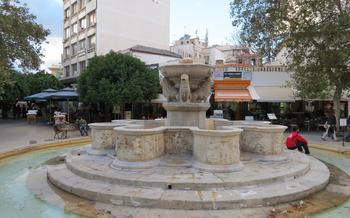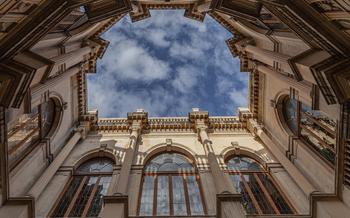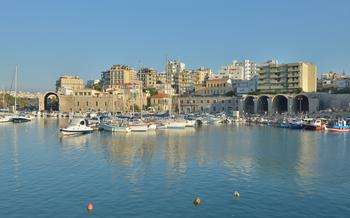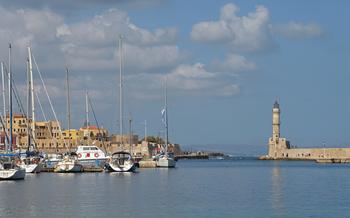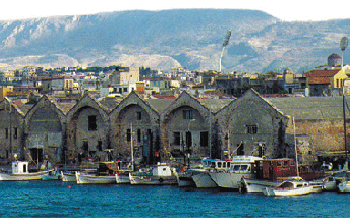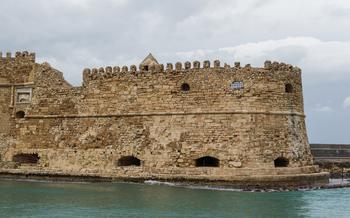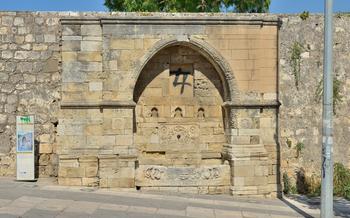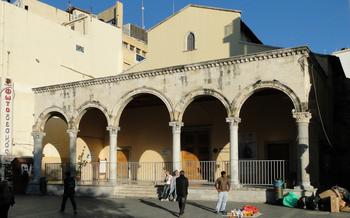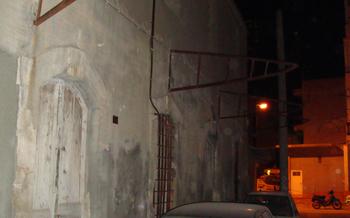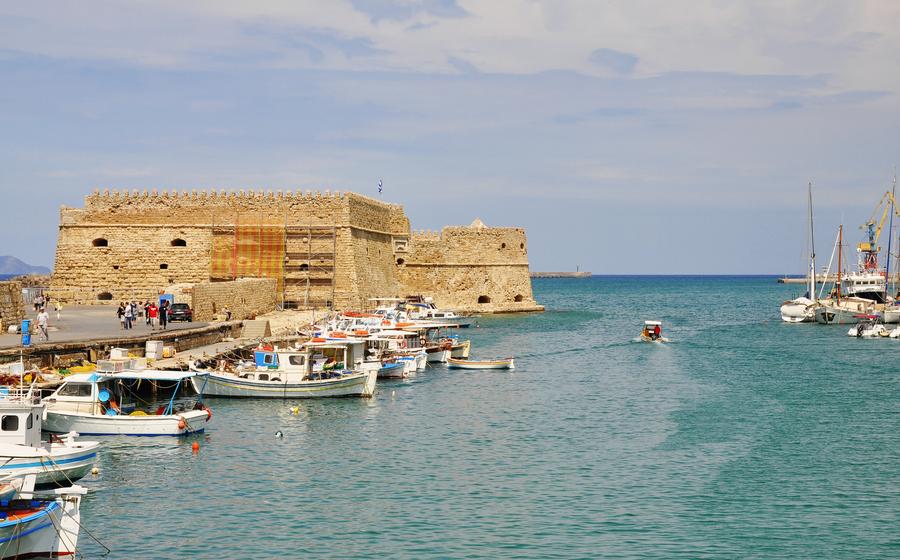
Koules Fortress
- A Venetian Fortress with a Rich Past
- Location and Accessibility
- Exploring the Fortress Grounds
- The Seaward Fortress
- The Landward Fortress
- Exhibitions and Displays
- Cultural Events and Performances
- Stunning Views from the Ramparts
- The Venetian Arsenal
- The Koules Lighthouse
- Practical Information
- Tips for Visiting the Koules Fortress
- Nearby Attractions
- Insider Tip: Unveiling the Secrets of Koules Fortress
A Venetian Fortress with a Rich Past
The Koules Fortress, an iconic landmark of Heraklion, stands proudly on the western edge of the Venetian harbor, guarding the entrance to the city. Its history dates back to the 13th century when the Venetians, who ruled Crete for over 400 years, recognized the strategic importance of this location. They constructed the fortress as part of their extensive fortifications to protect their maritime empire and control access to the island. The Koules Fortress played a crucial role in defending Heraklion against numerous attacks and invasions, becoming a symbol of Venetian power and resilience. Its architectural features, including the massive walls, towers, and embrasures, reflect the advanced military engineering skills of the Venetians and their commitment to securing their dominion over Crete. As a testament to its enduring significance, the Koules Fortress remains a prominent symbol of Heraklion's cultural heritage, attracting visitors from around the world who seek to explore its rich past and immerse themselves in the captivating history of Crete.
Location and Accessibility
The Koules Fortress stands proudly at the entrance to Heraklion's Venetian harbor, a strategic location that has shaped its history and significance. To reach this majestic fortress, one can embark on a scenic walk from the city center, taking in the vibrant atmosphere and historical landmarks along the way. The fortress is a mere 15-minute stroll from the heart of Heraklion, offering a pleasant and convenient journey.
For those who prefer a more leisurely mode of transport, buses and taxis are readily available to transport visitors to the fortress's doorstep. Ample parking is available in the vicinity, ensuring a hassle-free visit for those arriving by car.
Exploring the Fortress Grounds
The Koules Fortress is a labyrinth of walls, towers, and chambers, each revealing a different aspect of its rich history. As you step inside, you'll find yourself in a large courtyard, surrounded by imposing stone walls. From here, you can choose to follow the paths that lead to various sections of the fortress.
Walk along the ramparts and take in the stunning views of the harbor and the city. Climb to the top of the towers for a bird's-eye perspective of the surrounding area. Explore the dark and atmospheric chambers, where soldiers once lived and defended the fortress.
There are several areas within the fortress that are open to the public for exploration. You can wander through the former living quarters, where you'll see fireplaces, ovens, and other remnants of daily life. Visit the chapel, where soldiers prayed for victory before going into battle. Discover the cistern, which provided fresh water to the fortress's inhabitants.
A thorough visit to the Koules Fortress will take you around 1-2 hours, depending on your pace and level of interest. Be sure to wear comfortable shoes, as you'll be doing a lot of walking on uneven surfaces. And don't forget your camera to capture the many photo opportunities that await you.
The Seaward Fortress
The seaward fortress, also known as the Marine Fortress, stands as a testament to Venetian ingenuity and defensive prowess. Constructed as a separate entity from the landward fortress, the seaward fortress projected into the sea, forming a formidable barrier against naval attacks. Its strategic positioning allowed for a clear line of sight and fire towards approaching vessels, making it a crucial element in Heraklion's defense system.
The seaward fortress was meticulously designed with a series of cannons and embrasures, enabling the Venetians to unleash a devastating barrage of fire upon enemy ships. The embrasures, carefully positioned along the fortress walls, provided gunners with optimal angles for aiming and firing their cannons, maximizing their accuracy and effectiveness.
Beyond its defensive capabilities, the seaward fortress offered breathtaking views of the Venetian harbor and the vast expanse of the Mediterranean Sea. Visitors can climb to the ramparts of the fortress and marvel at the stunning panorama that unfolds before them. The azure waters of the harbor, dotted with fishing boats and yachts, create a picturesque contrast against the rugged fortress walls. The endless horizon of the Mediterranean Sea stretches out invitingly, evoking a sense of adventure and exploration.
The seaward fortress has witnessed numerous historical events and battles, serving as a silent sentinel to the turbulent past of Heraklion. It played a pivotal role in defending the city against Ottoman attacks, withstanding fierce assaults and demonstrating the resilience of the Venetian fortifications. The fortress stands as a testament to the ingenuity and determination of the Venetian Republic, which once held sway over the island of Crete.
The Landward Fortress
The landward fortress, also known as the Martinengo Bastion, played a crucial role in protecting Heraklion from attacks originating from the land. Its primary function was to safeguard the city's vulnerable eastern side, which was exposed to potential threats. The landward fortress featured a formidable entrance gate, reinforced with sturdy fortifications and defensive structures. These fortifications included thick walls, ramparts, and strategically placed cannons, creating a formidable barrier against any potential invaders. The gate served as the main point of entry and exit for the fortress, allowing controlled access to the city. Additionally, the landward fortress was connected to the city walls of Heraklion, forming an extensive defensive system that encircled the city and provided comprehensive protection against enemy forces.
Exhibitions and Displays
The Koules Fortress houses a range of exhibitions and displays that provide visitors with a deeper understanding of Crete's rich history and culture. Permanent exhibitions showcase artifacts and historical items recovered from the fortress and the surrounding area. These include ancient pottery, weapons, tools, and everyday objects that offer a glimpse into the lives of the Venetians and their Cretan subjects.
Temporary exhibitions are also organized throughout the year, featuring themes related to the fortress, Venetian Crete, or broader aspects of Greek and Mediterranean history. Multimedia presentations and interactive displays enhance the visitor experience, providing additional information and context for the artifacts on display.
Through these exhibitions, visitors can learn about the strategic importance of the fortress, the role of the Venetians in Crete, and the cultural heritage of Heraklion and the island as a whole. The displays offer a valuable opportunity to delve into the past and gain insights into the fascinating stories that have shaped this iconic landmark.
Cultural Events and Performances
The Koules Fortress, with its evocative atmosphere and stunning backdrop, serves as a captivating venue for a variety of cultural events and performances throughout the year. From intimate concerts to theatrical productions, the fortress transforms into a vibrant stage, offering visitors a unique and immersive experience.
The schedule of events varies, featuring both local and international artists, ensuring a diverse range of performances to suit all tastes. From traditional Cretan music concerts to contemporary dance shows, there's something for everyone to enjoy.
Attending a cultural event within the fortress walls is an unforgettable experience. The ancient stones reverberate with the sounds of music or the voices of actors, transporting visitors back in time. The interplay of light and shadow against the fortress's rugged walls creates a magical ambiance, enhancing the overall performance.
To fully immerse yourself in the cultural offerings of the Koules Fortress, plan your visit during one of these special events. Check the official website or local event calendars for the latest schedule. Whether you're a music enthusiast, a theater buff, or simply seeking a unique and memorable experience, the Koules Fortress promises an evening of entertainment and cultural enrichment.
Stunning Views from the Ramparts
For breathtaking panoramic vistas, ascend to the fortress's ramparts. The observation deck offers an unparalleled perspective of Heraklion city, stretching out before you in all its glory. The Venetian harbor, with its bobbing boats and shimmering turquoise waters, adds a vibrant touch to the cityscape. Beyond the city limits, the majestic mountains of Crete rise up, their peaks capped with snow during the winter months. The seemingly endless expanse of the Mediterranean Sea stretches out into the horizon, merging seamlessly with the cerulean sky.
Capture the beauty of Crete in stunning photographs from this vantage point. Whether you prefer wide-angle shots encompassing the entire panorama or close-ups highlighting specific landmarks, the Koules Fortress's ramparts provide endless opportunities for creative photography. As the sun begins its descent, the sky transforms into a canvas of vibrant hues, casting a magical glow upon the fortress and the surrounding landscape. This is the perfect time to witness the sunset, an unforgettable spectacle that will leave you in awe.
The Venetian Arsenal
The Koules Fortress also houses the remnants of the Venetian Arsenal, a once-thriving shipbuilding facility that played a crucial role in Heraklion's maritime history. Established during the Venetian rule in the 13th century, the arsenal served as a hub for constructing and repairing ships, contributing significantly to Venice's naval power in the Mediterranean. Today, visitors can explore the ruins of the arsenal within the fortress grounds, gaining insights into the city's rich maritime past. These remnants stand as a testament to the ingenuity and craftsmanship of the Venetian shipbuilders, who crafted vessels that sailed the seas, shaping the course of history. Understanding the significance of the Venetian Arsenal adds depth to the visitor's experience, revealing the intricate tapestry of Heraklion's maritime heritage.
The Koules Lighthouse
Within the imposing walls of the Koules Fortress stands a majestic lighthouse, a silent guardian that has guided countless seafarers through the treacherous waters of the Mediterranean Sea. Constructed during the Venetian era, the lighthouse served as a crucial navigational aid for ships entering and exiting the port of Heraklion. Its strategic position atop the fortress's ramparts allowed the light to be visible from miles away, providing a beacon of hope and safety for weary travelers.
The lighthouse's architectural design is a testament to Venetian engineering prowess. Its sturdy stone tower, adorned with intricate carvings and decorative elements, blends seamlessly with the fortress's fortifications. The lantern room, perched high above the sea, houses a powerful light that pierces the darkness, guiding ships to safety.
Over the centuries, the Koules Lighthouse has witnessed countless historical events unfolding before its watchful gaze. It has stood steadfast during battles, sieges, and the rise and fall of civilizations. Its light has guided Venetian galleys, Ottoman warships, and modern-day cruise ships alike, symbolizing the enduring spirit of Heraklion and its enduring maritime heritage.
Practical Information
For an enriching and hassle-free experience, it's essential to consider the practicalities before your visit to the Koules Fortress.
-
Entrance Fees: Admission to the fortress is subject to a modest entrance fee. Consider purchasing a combination ticket for entry to multiple historical sites in Heraklion to save on costs.
-
Opening Hours: The fortress is generally open to the public from morning until late afternoon, with extended hours during the summer tourist season. Check the official website or local tourist information centers for exact opening hours.
-
Accessibility: The fortress grounds are mostly accessible to visitors with disabilities, with ramps and designated pathways. However, some areas, such as the upper ramparts, may be challenging to navigate due to uneven surfaces.
-
Guided Tours: Guided tours of the fortress are available in various languages. These tours offer insightful commentary on the history, architecture, and significance of the fortress, enhancing the visitor experience.
Tips for Visiting the Koules Fortress
To make the most of your visit to the Koules Fortress, consider the following tips:
- Choose the right time: Aim to visit during the shoulder seasons (April-May or September-October) for pleasant weather and fewer crowds. Avoid the peak summer months (June-August) if you prefer a quieter experience.
- Plan a suitable duration: Allocate at least 1-2 hours for a thorough exploration of the fortress grounds, including time to walk along the ramparts, visit any exhibitions, and soak in the views.
- Pack the essentials: Bring along water, sunscreen, and comfortable walking shoes, as you'll be doing a fair amount of walking on uneven surfaces. A camera is a must for capturing the fortress's beauty.
- Capture the best shots: For stunning photographs, take advantage of the golden hour (just after sunrise or before sunset) when the light is at its most flattering. Experiment with different angles and perspectives to capture unique shots of the fortress.
Nearby Attractions
Surrounding the Koules Fortress, a treasure trove of historical sites and landmarks awaits exploration. Discover the Venetian Walls, an impressive fortification system encircling Heraklion's old town, offering a glimpse into the city's rich past. Admire the Loggia, an elegant Renaissance building once used for official ceremonies and meetings. Explore the Historical Museum of Crete, showcasing artifacts and exhibits that narrate the island's captivating history from ancient times to the present day. For a touch of nature, stroll through the Venetian Port, lined with charming cafes and restaurants, and admire the majestic yachts and boats moored along the waterfront. Plan your visit to coincide with one of Heraklion's vibrant festivals, such as the Venetian Carnival or the Feast of Saint Minas, to immerse yourself in the city's lively atmosphere and cultural traditions.
Combine your visit to the Koules Fortress with a broader exploration of Heraklion's many attractions. Consider a leisurely walk along the picturesque Promenade, offering stunning views of the Mediterranean Sea and the city's landmarks. Visit the Archaeological Museum of Heraklion, home to an exceptional collection of Minoan artifacts, including the famous Minoan snake goddess figurine. Don't miss the opportunity to savor the delights of Cretan cuisine at one of the traditional tavernas in the old town, where you can indulge in fresh seafood, aromatic herbs, and delicious local wines. Create a comprehensive travel plan that allows you to experience the diverse facets of Heraklion, from its ancient history to its vibrant present.
Insider Tip: Unveiling the Secrets of Koules Fortress
Venture beyond the main tourist paths to discover hidden corners of the Koules Fortress that offer unique perspectives and photo opportunities. As you explore the ramparts, keep an eye out for secluded nooks and crannies that provide breathtaking views of the Venetian harbor and the city skyline. These hidden spots are ideal for capturing stunning photographs that will serve as lasting mementos of your visit.
For a culinary experience with a view, head to one of the local restaurants or cafes situated near the fortress. These establishments offer delectable Cretan cuisine paired with panoramic vistas of the fortress and the sparkling Mediterranean Sea. Indulge in traditional dishes while enjoying the ambiance of this historic setting.
To make the most of your visit, plan your trip to coincide with one of the special events or festivals held at the Koules Fortress throughout the year. These events showcase the fortress's cultural significance and provide a unique opportunity to immerse yourself in the vibrant atmosphere of Heraklion. From concerts and theatrical performances to historical reenactments, there's always something special happening at this iconic landmark.
